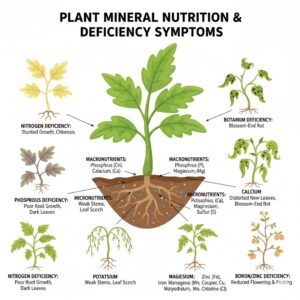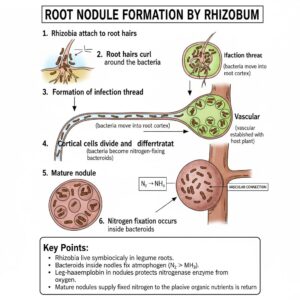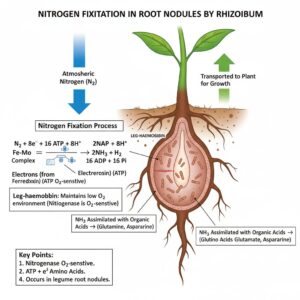1st PUC Biology Question and Answer: Mineral Nutrition
Looking for 1st PUC Biology textbook answers? You can download Chapter 12: Mineral Nutrition Questions and Answers PDF, Notes, and Summary here. 1st PUC Biology solutions follow the Karnataka State Board Syllabus, making it easier for students to revise and score higher in exams.
Karnataka 1st PUC Biology Textbook Answers—Reflections Chapter 12
Mineral Nutrition Questions and Answers, Notes, and Summary
1st PUC Biology Chapter 12
Mineral Nutrition

Scroll Down to Download Mineral Nutrition PDF
Question and Answer:
Question 1.
All elements that are present in a plant need not be essential to its survival’. Comment.
Answer:
All elements that are present in a plant need not be essential to its survival.
More than sixty elements have been found in different plants, but not all of them are necessary for the plant’s growth and development. Some plants may even accumulate elements like selenium, gold, or radioactive strontium without any known essential role.
An element is considered essential only if it satisfies the following criteria:
- The element must be absolutely necessary for supporting normal growth and reproduction.
- Its requirement must be specific and not replaceable by another element.
- It must be directly involved in the metabolism of the plant.
Thus, only those elements that meet these criteria are termed essential elements, while the others, though present, are not essential for the plant’s survival.
Question 2.
Why is purification of water and nutrient salts so important in studies involving mineral nutrition using hydroponics?
Answer:
In 1860, Julius von Sachs, a German botanist, demonstrated for the first time that plants could be grown to maturity in a defined nutrient solution in the complete absence of soil. The essence of these methods lies in growing plants in a soil-free, defined mineral solution. These methods require purified water and pure mineral nutrient salts because any impurities may introduce unknown elements that could affect the results. The presence of pure nutrients ensures clear, accurate, and scientific results in determining the essential elements required for plant growth.
Question 3.
Explain with examples: macronutrients, micronutrients, beneficial nutrients, toxic elements and essential elements.
Answer:
- Macronutrients:
These are elements required by plants in large quantities (more than 10 mmol/kg of dry matter).
Examples: Nitrogen (N), Phosphorus (P), Potassium (K), Calcium (Ca), Magnesium (Mg), Sulphur (S), Carbon (C), Hydrogen (H), and Oxygen (O). - Micronutrients (Trace elements):
These are required in very small amounts (less than 10 mmol/kg of dry matter).
Examples: Iron (Fe), Manganese (Mn), Zinc (Zn), Copper (Cu), Molybdenum (Mo), Boron (B), Chlorine (Cl), and Nickel (Ni). - Beneficial Nutrients:
These are elements that are not essential for all plants but may be required by certain higher plants for better growth and yield.
Examples: Sodium (Na), Silicon (Si), Cobalt (Co), and Selenium (Se). - Toxic Elements:
When the concentration of a micronutrient increases beyond the optimum range, it becomes toxic and reduces plant growth (about 10% reduction in dry weight).
Example: Excess Manganese (Mn) causes brown spots surrounded by chlorotic veins and also induces deficiencies of Fe, Mg, and Ca. - Essential Elements:
These are elements absolutely necessary for normal growth and reproduction of plants. Their deficiency prevents plants from completing their life cycle.
Examples: Nitrogen, Phosphorus, Potassium, Iron, Magnesium, etc.
Question 4.
Name at least five different deficiency symptoms in plants. Describe them and correlate them with the concerned mineral deficiency.
Answer:
Plants show characteristic deficiency symptoms when essential mineral elements are lacking. These symptoms depend on the function of the element and its mobility within the plant.
(i) Iron Deficiency:
- Cause: Iron becomes unavailable in alkaline or waterlogged soils.
- Symptoms: Yellowing between leaf veins (interveinal chlorosis), especially in young leaves, while veins remain green. Fruits are of poor quality.
- Treatment: Use slightly acidic soil (pH 5–6.5) and apply well-rotted manure or compost to improve iron availability.
(ii) Potassium Deficiency:
- Cause: Lack of potassium affects protein synthesis and regulation of stomatal opening.
- Symptoms: Brown scorching and curling of leaf tips, yellowing of veins, and sometimes purple spots on the underside of leaves.
- Treatment: Apply organic potassium-rich fertilizers such as seaweed meal or composted bracken.
(iii) Calcium Deficiency:
- Cause: Insufficient calcium or poor nutrient mobility.
- Symptoms: Stunted growth, necrosis on leaf margins of young leaves, curling of leaves, and death of root tips.
- Treatment: Add agricultural lime to acid soils and improve organic matter to enhance calcium absorption.
(iv) Nitrogen Deficiency:
- Cause: Nitrogen gets used by microorganisms when woody material (like sawdust) is added to soil.
- Symptoms: Stunted growth, pale green or yellow leaves, delayed flowering and fruiting.
- Treatment: Apply organic manure or grow leguminous crops to fix nitrogen.
(v) Manganese Deficiency:
- Cause: Common in poorly drained or highly organic soils.
- Symptoms: Interveinal chlorosis with small veins remaining green, brown spots on leaves, and withering of severely affected leaves.
- Treatment: Improve drainage and apply manganese-rich fertilizers.
Question 5.
If a plant shows a symptom which could develop due to deficiency of more than one nutrient, how would you find out experimentally, the real deficient mineral element?
Answer:
The deficiency of any element may produce multiple symptoms, and the same symptom can result from the deficiency of different elements. To identify the real deficient element, one must carefully study all the symptoms developed in different parts of the plant and compare them with standard deficiency symptom tables. It is also important to note that different plants may respond differently to the deficiency of the same element.
Question 6.
Why is that in certain plants deficiency symptoms appear first in younger parts of the plant while in others they do so in mature organs?
Answer:
Deficiency symptoms depend on the mobility of the element in plants.
- Mobile elements (like Nitrogen, Potassium, and Magnesium) are actively transported from older tissues to young developing tissues. Therefore, their deficiency symptoms first appear in older leaves.
- Immobile elements (like Sulphur and Calcium) cannot be easily transported from mature organs. Hence, their deficiency symptoms first appear in young tissues or growing regions.
Question 7.
How are the minerals absorbed by the plants?
Answer:
Studies show that mineral absorption occurs in two main phases:
- Apoplastic (Passive) Uptake:
- Rapid entry of ions into the ‘free space’ or apoplast of cells.
- Occurs through ion channels in cell membranes and does not require energy.
- Symplastic (Active) Uptake:
- Slow entry of ions into the symplast of cells.
- Requires metabolic energy (ATP) and involves active transport.
- Influx is inward movement, and efflux is outward movement of ions.
Translocation:
Minerals are transported through xylem along with water pulled by transpirational pull. Xylem sap contains mineral salts, and radioisotope studies confirm their movement.
Question 8.
What are the conditions necessary for fixation of atmospheric nitrogen by Rhizobium. What is their role in N₂-fixation?
Answer:
Conditions for N₂ Fixation:
- Presence of the enzyme nitrogenase (dinitrogenase).
- Anaerobic conditions around nitrogenase to protect it from oxygen.
- Energy source (ATP) to drive the reaction.
- Electron donors such as NADPH, FMNH₂, or ferredoxin.
- Deficiency of nitrate in the soil to induce nodule formation.
- Organic carbon sources (like keto acids) for bacterial metabolism.
Role in Nitrogen Fixation:
- ATP provides energy for nitrogenase, and ferredoxin supplies electrons.
- Atmospheric N₂ binds to the Fe-Mo component of nitrogenase, weakening the triple bond between the nitrogen atoms.
- In the presence of energy and electrons, hydrogen combines with nitrogen atoms to form N₂H₂ (diamide), N₂H₄ (hydrazine), and NH₃ (ammonia).
- A reducing environment is essential and is maintained by leg-haemoglobin, which scavenges oxygen and releases it in small amounts.
- The produced ammonia is immediately assimilated with the help of organic acids to form amino acids, which are then used by the plant.
Question 9.
What are the steps involved in the formation of a root nodule?
Answer:
Nodule formation involves a sequence of interactions between Rhizobium and the roots of the host plant. The principal stages are:
- Colonization: Rhizobia multiply around the root and attach to epidermal and root hair cells.
- Root hair curling and invasion: The root hairs curl, and bacteria invade the root hair.
- Infection thread formation: An infection thread is produced, carrying the bacteria into the cortex of the root.
- Differentiation of cells: Bacteria are released into cortical cells, which differentiate into specialized nitrogen-fixing cells (bacteroids).
- Nodule maturation: The nodule establishes a vascular connection with the host plant, allowing exchange of nutrients and supporting nitrogen fixation.

Question 10.
Which of the following statements are true ? If false, correct them:
- Boron deficiency leads to stout axis.
- Every mineral element that is present in a cell is needed by the cell.
- Nitrogen as a nutrient element, is highly immobile in the plants.
- It is very easy to establish the essentiality of micronutrients because they are required only in trace quantities.
Answer:
- (Correct – All areas of high metabolic activity like stem tips and root tips get killed; stunting of the stem and root growth; chlorosis necrosis and distortion of leaves; reduced flowering and fruiting).
- True
- True
- True
Additional Questions and Answers – Mineral Nutrition
Question 1.
Define essential nutrients for plants. How are they classified?
Answer:
Essential nutrients are elements required by plants to complete their life cycle. They are classified into:
- Macronutrients: Needed in large quantities (e.g., Nitrogen, Phosphorus, Potassium, Calcium, Magnesium, Sulfur)
- Micronutrients: Needed in trace amounts (e.g., Iron, Manganese, Zinc, Copper, Boron, Molybdenum, Chlorine, Nickel)
Question 2. What is the difference between mobile and immobile nutrients? Give examples.
Answer:
- Mobile nutrients: Can move from older to younger parts of the plant (e.g., Nitrogen, Phosphorus, Potassium)
- Immobile nutrients: Cannot move easily, so deficiency symptoms appear in new leaves (e.g., Calcium, Boron, Sulfur)
Question 3.
Explain the role of nitrogen in plants.
Answer:
- Nitrogen is a component of amino acids, proteins, nucleic acids, and chlorophyll.
- Promotes vegetative growth and green leaves.
- Deficiency causes stunted growth and yellowing of older leaves (chlorosis).
Question 4.
How does phosphorus deficiency affect plants?
Answer:
- Phosphorus is needed for ATP, nucleic acids, and phospholipids.
- Deficiency results in poor root development, delayed maturity, and purplish coloration of leaves.
Question 5.
Describe the function of potassium in plants.
Answer:
- Potassium regulates stomatal opening, enzyme activation, photosynthesis, and translocation of food.
- Deficiency causes weak stems, scorched leaf margins, and reduced yield.
Question 6.
What are hydroponics? Mention its advantages.
Answer:
- Hydroponics is a method of growing plants without soil, using nutrient solutions.
- Advantages:
- Saves space and water
- Faster growth
- Reduces soil-borne diseases
- Nutrient supply can be controlled
Question 7.
Explain the role of Rhizobium in nitrogen nutrition.
Answer:
- Rhizobium is a nitrogen-fixing bacterium that forms root nodules in legumes.
- Converts atmospheric nitrogen (N₂) into ammonia (NH₃) that plants can use.
- Enhances soil fertility naturally.
Question 8.
What is chlorosis? Which nutrient deficiencies cause it?
Answer:
- Chlorosis is the yellowing of leaves due to insufficient chlorophyll.
- Caused by deficiencies of Nitrogen, Iron, Magnesium, or Sulfur.
Question 9.
Why is boron considered important for plants?
Answer:
- Boron is essential for cell wall formation, membrane integrity, and sugar transport.
- Deficiency causes death of growing points and deformities in leaves and fruits.
Question 10.
Compare mycorrhizal and rhizobial associations.
Answer:
Feature | Mycorrhiza | Rhizobium |
Type of plant | Most plants | Legumes only |
Type of association | Fungal | Bacterial |
Function | Enhances nutrient & water uptake | Fixes atmospheric nitrogen |
Location | Roots (fungal hyphae) | Root nodules |
Question 11.
How can we correct nutrient deficiencies in crops?
Answer:
- Apply fertilizers (NPK, micronutrient salts)
- Use organic manures like compost, farmyard manure
- Practice crop rotation with legumes to naturally enrich nitrogen
Question 12.
Describe the steps in root nodule formation.
Answer:
- Rhizobia attach to root hairs.
- Root hairs curl, and bacteria enter forming an infection thread.
- Infection thread grows into the cortex cells.
- Cortical cells divide, forming the nodule.
- Rhizobia differentiate into bacteroids and fix nitrogen.

